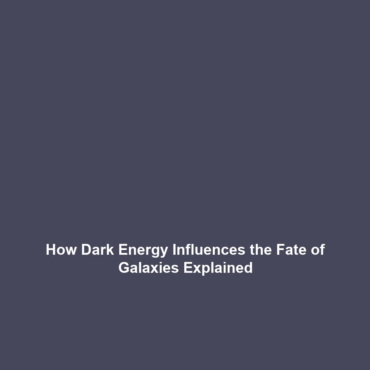How Will Dark Energy Shape the Fate of Galaxies?
Introduction
Dark energy is an enigmatic phenomenon that is believed to comprise approximately 68% of the universe’s total energy density. Understanding how dark energy shapes the fate of galaxies is critical for astronomers and physicists. This exploration is essential within the broader context of dark matter and dark energy, as it helps reveal the universe’s ultimate destiny. As galaxies interact and evolve over cosmic time, the roles of both dark matter and dark energy become increasingly significant.
Key Concepts
Understanding Dark Energy
Dark energy is a force that drives the accelerated expansion of the universe. It counteracts the gravitational attractive force of matter, including dark matter, leading to complex evolutionary paths for galaxies.
The Fate of Galaxies
The fate of galaxies depends on the understanding of dark energy. As galaxies are pulled apart by the expansion caused by dark energy, their eventual destiny will be influenced by how this mysterious force interacts with dark matter, potentially leading to the isolation of galaxies over billions of years.
Applications and Real-World Uses
The study of dark energy has numerous applications in astrophysics and cosmology. Here are some significant examples:
- Cosmological Models: Theoretical frameworks that incorporate dark energy inform our understanding of the universe’s expansion.
- Astronomical Observations: Observations of distant supernovae have provided insights into the characteristics of dark energy.
- Future Missions: Upcoming space telescopes aim to further investigate dark energy and its impact on galaxy formation and evolution.
Current Challenges
Despite advancements in our understanding of dark energy, several challenges remain:
- The Nature of Dark Energy: The exact nature and origin of dark energy are still unknown.
- Measurement Difficulties: Accurately measuring the effects of dark energy on distant galaxies poses significant challenges.
- Modeling Issues: Current models that describe the universe’s expansion are still insufficiently precise.
Future Research and Innovations
Future research regarding dark energy will likely focus on several key areas:
- Next-Gen Telescopes: Telescopes such as the James Webb Space Telescope will provide new data on galaxy formation influenced by dark energy.
- Gravitational Waves: Understanding how dark energy interacts with gravitational waves could revolutionize astrophysical theories.
- Theoretical Developments: New theories may emerge to better explain dark energy’s role in cosmic evolution.
Conclusion
In conclusion, dark energy plays a crucial role in shaping the fate of galaxies within the broader context of dark matter and dark energy. Continued research is essential for unraveling its mysteries, which could lead to revolutionary discoveries in astrophysics. To learn more about related topics, visit our sections on Dark Matter and Cosmology.









